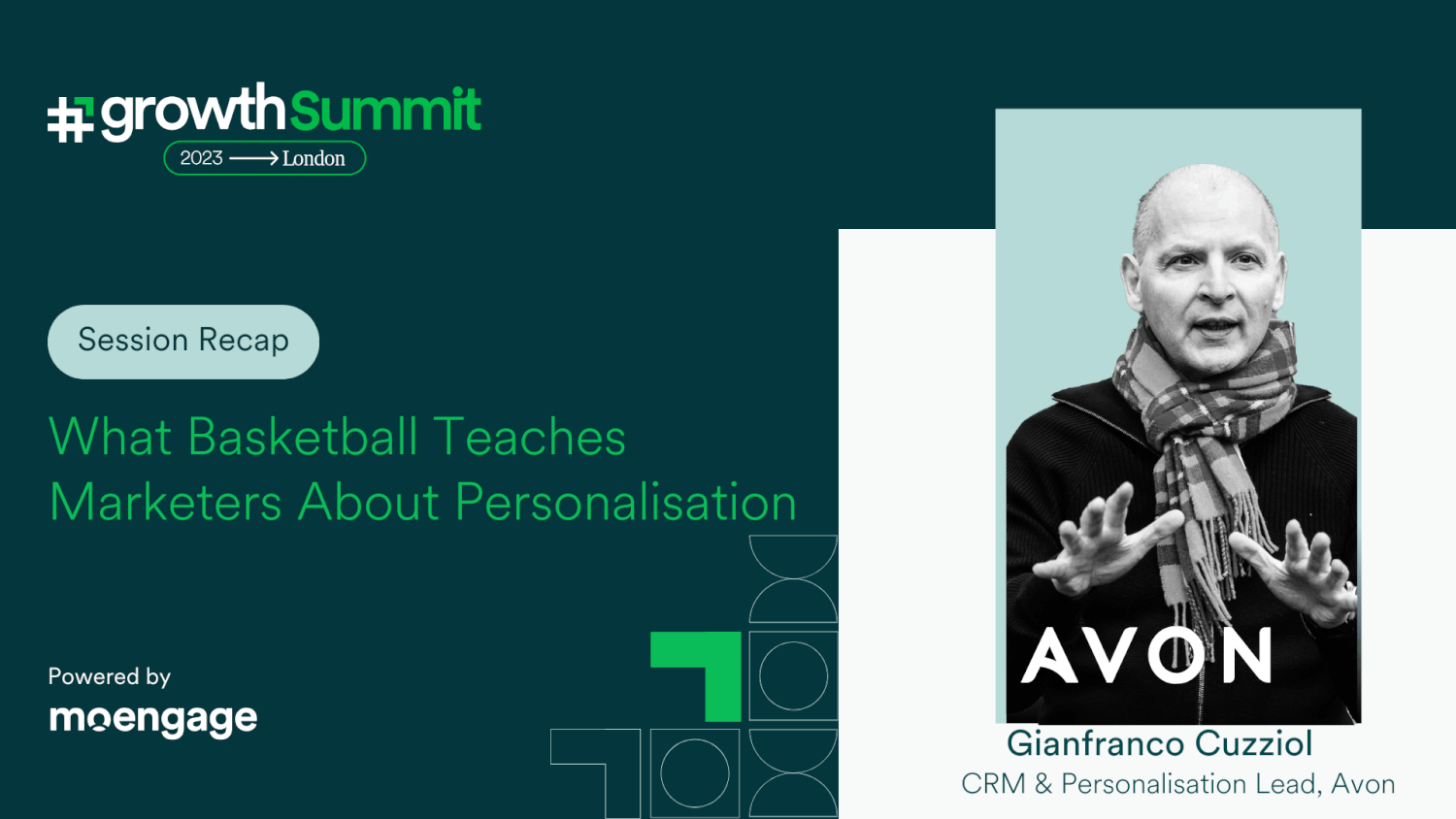What Basketball Teaches Marketers About Personalisation

Reading Time: 4 minutes
Nothing personal, but personalisation may only sometimes be the right strategy to engage with your customers effectively and retain them. Simply put, personalisation is pointless unless it’s solving a problem or meeting a desire. But how do you determine whether personalisation is solving a problem for your brand?
This was the question Gianfranco Cuzziol had the attendees of his #GROWTH Summit session ponder over. However, before getting into what his session covered, let’s look at Gianfranco’s journey with customer engagement and personalisation.
Meet the Personalisation Pioneer: Gianfranco Cuzziol
Gianfranco is an engaging individual who has traversed the agency-client side divide. Experienced CRM, Data, and Business Transformation expert with a track record of setting and delivering customer strategy with customer and business objectives at the centre.
Four years ago, an opportunity arose for him to delve into the world of customer relationship management (CRM) alongside some incredible brands. His journey began as the Global Head of CRM at Leop, where he embarked on an enriching experience that transformed how the brand engaged with customers beyond the physical store.
The challenge was to extend the conversation post-store visits, ensuring an ongoing remarkable experience by replicating the in-store ambiance digitally. This led to fascinating dialogues from a digital standpoint, establishing connections and carrying forward the brand ethos.
He has worked with various platforms and brands throughout his professional tenure, from spearheading CRM for a new marketing platform to contributing expertise to ESOP Avon and The Body Shop. In the past nine months, his focus has centered on collaborating with Avon to enhance their CRM, personalisation vision, technological adoption, and organisational growth.
The Roots of Basketball and Its Unforeseen Evolution
Gian transported attendees back to December 1891 in Springfield, Massachusetts, where Dr. James Naismith faced the challenge of keeping 18 young men fit during the harsh cold. He ingeniously crafted a game using a soccer ball, peach baskets, and a gym, birthing the sport of basketball.
The early version involved splitting teams, placing baskets at either end of the gym, and scoring by putting the ball in the opponent’s basket. But there was a snag – retrieving the ball after each score proved cumbersome until a hole was introduced at the basket’s bottom.
Interestingly, the sport’s evolution ties in with player height. If we examine basketball history from the 1950s onwards, there’s a noticeable trend: players grew taller, barring a dip around the 1980s. This surprising shift stems from an alteration in scoring rule.
A Game-Changing Shift: From Two Points to Three
Around the 1980s, a rule change occurred in basketball – introducing a three-point line, approximately 22 feet from the hoop. Scoring from this line would yield three points instead of the traditional two. This modification revolutionised the game and, unexpectedly, impacted player heights.
Analysing shooting accuracy, there’s a marginal 5-10% drop in accuracy beyond the 20-foot mark. Despite this decline, players strategically step back, trading a slight accuracy reduction for a significant points increase.
Applying Basketball Insights to Personalised Customer Engagement
Parallels emerge between basketball’s evolution and customer relationship strategies. Just as basketball players traded in accuracy reduction for a higher return, marketers should do the same when it comes to personalisation.
When designing loyalty programs or personalised interactions, aligning with the brand’s ethos and understanding customer journeys is crucial. Personalisation doesn’t always necessitate hyper-segmentation; sometimes, authenticity resonates more profoundly with customers.
Key Pillars of Effective Personalisation
Three fundamental pillars underpin effective personalisation strategies: understanding the customer, building trust, and reinforcing brand identity. Technology plays a supporting role, not the lead, in this journey.
1. The Customer
Customer-centricity is vital to a brand’s sustainable growth. Think about what your customer is trying to do, the motivation behind them taking specific actions, and the obstacles they face in their journey with you. Let in-depth customer data and analytics be your guide here.
Your aim should be to make the journey frictionless for them and to meet them wherever they are. Be it WhatsApp, Email, In-App or any other.
2. The Brand
While talking about Aesop, Gian mentioned that they didn’t personalise communication too much to stay true to the brand. Because the brand became much more authentic to the customer when they spoke about their brand values and culture. This resulted in better returns compared to what a highly segmented and personalised campaign might have given.
Understand the true essence of your brand, then ask yourself if you should personalise.
3. The Trust
Think about ethics and privacy from a customer point of view. Get your board involved here, ask them to think about the quality of the data they’d like to collect, get them to ponder over what ethically collected data could do for your brand perception and value.
Gianfranco’s rich but actionable session impressed attendees and keyed up for the next session, the fireside chat with Liz Earle!
Want to hear more from Gianfranco and his take on how “Personalisation without purpose is pointless?” check out his webinar here!
Lessons Learned and Strategies Defined
My experiences have crystallised into guiding principles for successful customer engagement. Balancing technological advancements with customer needs, understanding the evolving customer journey, and aligning loyalty programs with brand values remain paramount.
In conclusion, just as basketball continually refines its rules, customer engagement strategies must adapt to unforeseen shifts. The essence lies not in a singular approach but in a dynamic, adaptable methodology tailored to brand identity and customer aspirations.
Understanding, trust, and authenticity will perennially be the cornerstones of effective customer relationship management, resonating across the ever-evolving landscape of business and customer interactions.
Read more session recaps from other exciting discussions at our #GROWTH Summits 🚀:
-
Liz Earle MBE Shares Success Story and Advice at #GROWTH Summit London 2023
-
Customer Journey to Nowhere: The Funny Side of Customer Engagement With Marketoonist
-
Driving Customer Engagement With Hyper-Personalization and Automation
-
Building the Modern Martech Stack: The Ins and Outs, and Role AI Will Play
-
The #GROWTH Story of Poshmark













